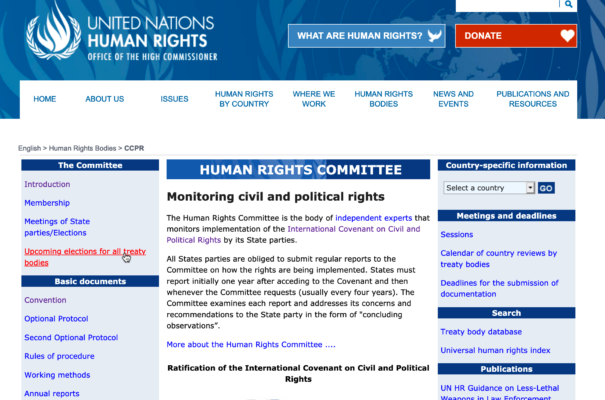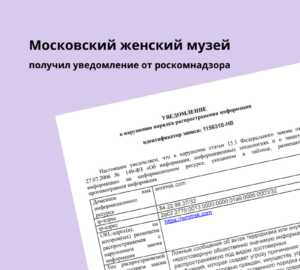Катерина Бахренькова: Представление в Комитет по правам человека ООН от НЕТ ФЕМИЦИДУ
годовой доклад о фемициде 2019:
рус — https://www.wmmsk.com/2020/03/femicidrf2019-v30/
англ — https://www.wmmsk.com/2020/03/fn2019/
есть в печатной форме, можно получить у коллектива в Москве или по почте
В докладе цифры на 8 марта 2020. Количество убийств женщин мужчинами в 2019 году в базе femicid.net 1518 случаев, коэффициент 1,96 (количество случаев на 100 000 женского населения), в ООН ушли цифры за 2019, содержащиеся в базе на 31 мая 2020 — 1648 случаев, коэффициент 2,12. Изменение количества связано с тем, что в проекте анализируются случаи, попавшие в новости. Убийство может попасть в новость на разных стадиях, в том числе только после вынесения приговора, тогда нам станет известно о нём значительно позже.
Комментарии медиа по поводу проекта, собираемой статистики и фемицида как явления могут дать: Анна Гайдук, Любава Малышева, Нина Тян, Katerina Bakhrenkova
Распространение материалов femicid.net, отчётов свободное, не требует разрешения и крайне приветствуется.
For the UN Human Rights Committee
session 129 pdf
Femicid.net (НЕТ ФЕМИЦИДУ, NO TO FEMICIDE) — is an independent project. In 2019 the project began to collect news about femicide and publish data in the public domain. The project start it’s work because the society doesn’t have full and true information about the femicide in Russia and authorities don’t acknowledge the femicide as a problem .
Researchers of the project looked at publically accessible news sites in all 84 regions of Russia (excluding annexed Crimea and Sevastopol) and noted reports about killing of women. The information was then checked against websites of the prosecutor’s offices, courts, and investigative committees. The resulting data was then entered into a table that reflected demography, social status, relations between the victim and the perpetrator, circumstances of the crime, the course of the investigation and its conclusion.
The current information is based upon the report “Word of the Year in Russia: Femicide” presented by Femicid.net on 8th of March 2020, and data, collected by the project about killings of women in Russia in 2019.
The situation with femicide in Russian Federation shows the failure of the State to comply with its obligations under Article 2 (non-discrimination), Article 3 (equality for women and men) and Article 6 (the right to life).
Femicide in Russian Federation
Russian laws do not define “gender-based violence” and “femicide”. From the report of the Ministry of Internal Affairs, Crime Status (January-September 2019), we cannot find out how many women were killed in 2019. A visit to the federal statistics website to find answers to questions of interest to us is futile.
As of May 31, 2020, femicid.net database contained 1648 news of femicide for the year 2019, including 1447 news of intimate femicide, where we used only the news of the murders by relatives (including any intimate partners) and acquaintances.The crime could fall into our study in the form of news about the murder, search, investigation, trial, sentence, attempt to falsify the case. When new data appeared in the progress of the investigation, they were added to the table.
The coefficient of femicide reported in the news, CNF, was calculated according to the standard formula that is used all over the world: the number of murders was divided by the number of female population in the district (region) and multiplied by 100 thousand. We calculated the coefficient for all detected cases of femicide in general and separately for those in which the killer partner was familiar to the victim (coefficient of intimate femicide reported in news, CNFi).
As of May 31, 2020, the coefficient of femicide reported in news (CNF) for Russian Federation is 2,13, the coefficient of intimate femicide reported in news (CNFi) is 1,87. The coefficients of different regions of Russia varу a lot — from 8.22 in Magadan Oblast, 4.3 in Kirov Oblast to 0.37 in Republic of Ingushetia, 0.14 in Chechen Republic (the regions of North Caucasus, where honor killings have been reported and there the lack of independent media is presented).
We want to emphasize that the CNF is calculated on the news and does not reflect the real situation with the killings, CNF (I) in our calculations is not only news on femicide from “husbands”. Obviously, the actual femicide ratio is even greater.
On November 22, 2019, we attended the Moscow meeting of the Swedish and Russian parliamentarians, where the representative of the Russian Ministry of Internal Affairs, the head of the Office of Law Enforcement Organization in the Residential Sector and activities to implement the administrative legislation of the Main Directorate for ensuring the protection of public order and coordination with executive authorities of the constituent entities of the Russian Federation Ministry of the Interior of the Russian Federation (GUOOOP MIA of Russia), police colonel Stanislav Kolesnik said in Russia in 2019, 175 women died in the family. Apparently, the Ministry of Internal Affairs considers only marital violence “domestic”.
As of May 31, 2020, we found news of 685 cases of femicide from an intimate partner, 81 – from a former intimate partner (total 766), 304 from other male relatives (including 168 – son, 29 – grandson, 75 – close male relative) and 377 – from acquaintances, 1 – murder of a woman by police, a district police officer and his colleagues. As for the category of “acquaintances”, as well as the category of “unknown” (151) and “unacquainted сriminal” (49) – there intimacy, close connection of any kind with the victim, are also not excluded.
Almost all Russian published state statistics on violence are untrue. The number of femicides is diligently understated: “According to the data of the Ministry of Internal Affairs for 2015 304 women died at the hands of husbands, and not 14,000 at all”. These statistics were voiced by a senator from the Omsk region (20 news about femicide, CNF 2.58) Elena Mizulina, speaking in the Federation Council. What exact criteria were used to calculate this figure remains unknown.
Where are femicides hidden? From the collection of the Federal State Statistics Service 2018 “Women and men of Russia. 2018” we can learn that, for example, in 2017, 36 200 women died from “external causes of death”. Federal State Statistics Bureau aka Rosstat considers poisoning, accidental falls, strangulation or drowning, damage without specifying their accidental or intentional nature, accidents caused by electric shock, fire, firearms, accidents during treatment, suicide, traffic accidents, death from terrorism and on war, killings as the external causes of death. One glance at this list is enough to understand that behind each of the external causes there will be a hidden femicide.
To create a public opinion that there is no femicide the idea “women also kill, and with particular cruelty” is used. The same argument is heard from the proponents of domestic violence: “women also hit, and with particular cruelty.”
Among the especially serious crimes committed by women, a large number are suspicious of self-defense (self-defense in 79% of cases), the consequences of rape, systemic patriarchal terror for life, exhaustion from unpaid reproductive work. Part of the “female” crimes are committed in the interests of men; the question “what part” can be answered only by examining the cases.
Women make up 54% of Russia’s population (Russian Statistical Yearbook 2018). That is, 54% of the population (female class) commits 16% of crimes, and 46% of the population (male class) – 84% of crimes. Women commit significantly fewer crimes. What are these crimes and against whom are they committed?
Let’s look at the table Distribution of women and men who committed crimes in 2017 by type of crime.
In 2017, women committed 15.2% of all crimes, men 84.8%. Among male crimes, 87% (among female crimes of 13%) are especially serious. 1,400 female murders and attempted murders – including self-defense, assassination attempts, collective suicide of mothers and children, female femicide, etc. – stand against 7900 murders and attempted murders – both against women and against men. 18.1% of the intentional infliction of grievous bodily harm is also stratified into the above categories. Some part of the especially grave crimes are committed by 9.8% of criminals – minors. A more detailed study of the motives of “female” murders would greatly change public views on the “special danger and cruelty of women”.
From the following official table, we see that the number of women and men victims of crimes related to violent acts in 2017 is also uneven.
The number of affected men is 57.9%, and the number of affected women is 42.1%. It seems that some equality has been achieved here, if we miss out that the most serious crimes are committed by men anyway (87%), including those against other men. Men are killed mainly by men.
According to a report by the “Anna Center”, published in March 2020, 40% of women’s murders remain latent, that is, fall into other categories of statistics. “A number of studies conducted on the basis of primary non-personalized data sources on mortality in certain regions of Russia confirmed the assumption that deaths from homicide are underestimated. For example, researchers have shown that for the Sakhalin region real losses from murders in men exceeded the official figures by 2.9 times, and among women by 2.5 times.” Semenova V.G, Gavrilova N.S., Zaporozhchenko V.G. “Problems of accounting for mortality from external causes, 2017”.
We are sure that such situation results from refusal of Russian Federation to admit that the inequality and discrimination on the grounds of gender are exist and the special action must be taken to eliminate it. The declarative norms in the Constitution and several laws are not enough to do this. Russian Federation promotes “traditional family values” and such politics enroots stereotypes about gender roles and increase inequality between genders, which lead to discrimination. Femicide is the highest form of descrimination against women, femicide is the result of “traditional” idea that women are the property of men and men have the right to dictate women’s fate.
Russian Federation still has no effective state program against violence against women. There is no legislation to provide equality between women and men, no legislation about gender-related violence, including domestic violence.
There is no ministry for women and equal opportunities.
Women are quite scarcely represented among positions of high authority. Reaching the heights of the power pyramid, they remain puppets acting in the interests of men. The State Duma of the Russian Federation has a Committee on Family, Women and Children, and a Gender Coordination Council has been created at the Russian Ministry of Labor, but they work against women’s rights. E.g. the aforementioned committee of the State Duma was headed by Elena Mizulina, who is the author of the actual law on decriminalization of beatings. The Coordination Council under the Ministry of Labor has not met for 4 years.
There is a popular belief that the offender is not stopped by cruelty, but by the inevitability of punishment. In the case of femicides, we see dozens of relapses, light sentences and shortened isolation periods. A sentence for participation in a demonstration or repost in social media can be harder than for killing a female. Male killers know that the punishment will be insignificant even in case of second and third crime against a person. Leaving at large after an apparent murder, probation or release in a courtroom is not uncommon in femicid cases in Russia.
The questions for Russian Federation:
- Does Russian Federation acknowledge the femicide in Russia as an existing problem?
- What has been done to improve statistics about gender-related crimes, especially killings of women? What has been done to open these data and publish it freely?
- Do the law enforcement authorities pay special attention to the crimes committed by men against their relatives and intimate partners?
- What have been done, what kind of preventive measures have been implemented to protect women from being killed by their intimate partners and relatives?
- Are there any state programs that teach children and adults gender equality, respectful interaction and non-aggressive responses?
31.5.2020


